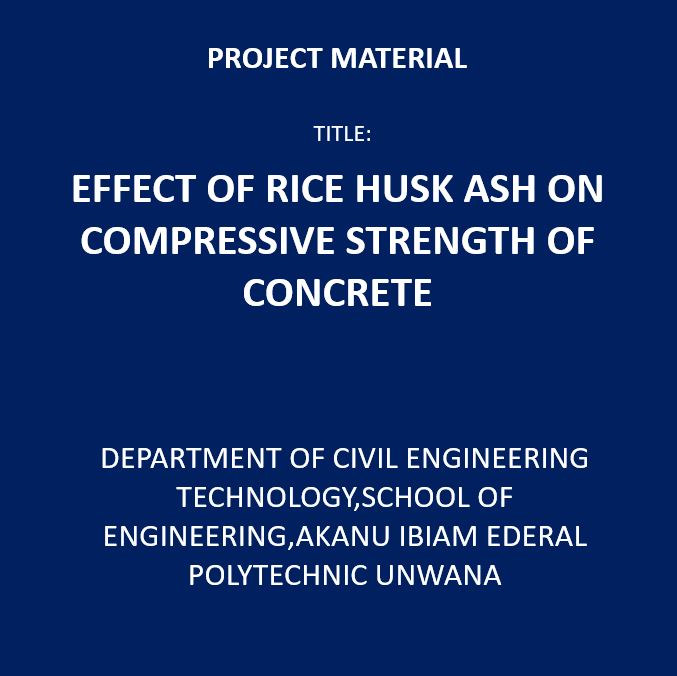No products in the cart.
Effects of Rice Husk Ash on Compressive Strength of Concrete
₦10,150.00
EFFECT OF RICE HUSK ASH ON COMPRESSIVE STRENGTH OF CONCRETE
- PROJECT YEAR:2023
- NUMBER OF PAGES: 74
- INSTITUTE: DEPARTMENT OF CIVIL ENGINEERING TECHNOLOGY,SCHOOL OF ENGINEERING,AKANU IBIAM EDERAL POLYTECHNIC UNWANA
ABSTRACT
This study focuses on the Effect of Rice Husk Ash on compressive strength of concrete produced using Unwana river sand and coarse aggregates ;clean water sourced from Poly unwana hostel, ordinary Portland cement(UNICEM), Rice Husk sourced from Afikpo rice mill and sieved with 150um sieve to produced Rice Husk Ash (RHA). In this research, 1:2:4 mix ratio was used and the mold dimension used was 150mm x150mm x150mm with varying water cement ratios i.e., 0.50, 0.55, 0.60, 0.65 and 0.70 and 5% intervals of Rice Husk Ash (RHA) varying from 5-25 percent as a partial replacement of cement. Preliminary laboratory tests such as sieve analysis was conducted to ascertain the suitability of using the aggregates. Also, slump test was conducted on the fresh concrete while compressive strength test was carried out on the hardened concrete cubes using compressive crushing machine of 2000KN capacity. The results of the tests on the fresh concretes shows that the work ability of the concrete was very low and it increased with increased in water cement ratio, the sieve analysis test showed that the rivers and falls at zone I fine aggregates. A total of fifteen(15) concrete cubes were produced, three(3) for each of the percentage replacement of RHA varying from 5-25%. All of the concrete cubes were crushed on the 28 days. At 28 days curing age, the compressive strength were; 21.8N/mm2 for 5% RHA, 14.52N/mm2 for 10% RHA, 13.04N/mm2 for 15% RHA, 10.7N/mm2 for 20% RHA and 10.10N/mm2 for 25%. However, the compressive strength decreases from 21.8N/mm2 to 10.10N/mm2 with increase in Rice Husk Ash. The experimental results show that 5% Rice Husk Ash (RHA) produced the highest compressive strength value of21.8 N/mm2 at 28days curing age. The study recommends that 5% RHA should be used to produce a grade C20 concrete. This 5 percent RHA replacement of cement will help reduce the overall cost of concrete and minimize environmental waste and depletion of the ozone layer.
No product has been found!
